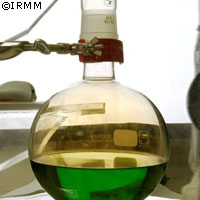A meeting with the masters of metrology
For over 25 years the European Commission's Joint Research Centre has provided support to the International Atomic Energy Agency in its efforts to oversee the implementation of the Nuclear Non-Proliferation Treaty. A good deal of this nuclear safeguards work involves measuring the levels of various radioactive isotopes in samples taken from nuclear installations and elsewhere. Isotopes are versions of the same element which have different numbers of neutrons, and analysing the relative amounts of the isotopes can tell scientists a lot about where a substance has come from and how it was produced. Helping to ensure these measurements are accurate is the Isotope Measurements Unit at the JRC's Institute for Reference Materials and Measurements (IRMM), which is based just outside the Flemish town of Geel in northern Belgium. CORDIS News took a tour of the unit's laboratories in the company of Roger Wellum, the IRMM's Safeguards Coordinator. 'In the nuclear field you have to be accurate to within a fraction of a per cent,' explained Dr Wellum. 'The measurement has to be calibrated so reference materials are a fundamental part of the measurement system.' Producing certified reference materials is a key function of the IRMM. Entering the labs requires security clearance and entails donning plastic overshoes and a lab coat. A dosimeter tucked into the lab coat pocket completes the outfit and thus attired, we shuffle off down the corridor. In the first lab we enter, an emerald green solution is sitting in a glass bottle inside a glove box. The liquid represents the first stage of production of a 'Large Sized Dried (LSD) Spike'. Well characterised pieces of uranium and plutonium metal are dissolved in nitric acid, a process that can take several weeks. Then, the solution is divided up into around 1,000 vials and dried. The final product is used by nuclear safeguards inspectors and others to measure the amount of dissolved reactor fuels at reprocessing plants such as Sellafield, La Hague and Rokkasho in Japan. An area of growing importance for nuclear safeguards inspectors is environmental sampling. Very often this means taking 'swipes' inside a nuclear facility, which entails wiping surfaces with a cotton cloth and then looking at the cloth to see what kinds of nuclear particles it picks up. The nuclear profile of these dust particles can then be analysed, and compared to what kinds of particles would be expected given the officially stated activity of the facility. Scientists at the IRMM are developing a method for producing reference particles with certified abundances of different isotopes of uranium, something which is urgently needed. In another lab we see the reaction chamber scientists use to create realistic uranium particles from uranium hexafluoride (UF6) gas. The work of the Isotope Measurement Unit is not restricted to the nuclear field. Another ongoing project is the search to define the kilogram. Over the years, scientists have defined units of measurements on the basis of 'pure' measurements. For example, one metre is equal to 'the length of the path travelled by light in vacuum during a time interval of 1/299 792 458 of a second'. However, the reference for the kilogram remains a lump of platinum/iridium metal stored at the International Bureau of Weights and Measures on the outskirts of Paris. Defining the kilogram according to a 'pure' measure is proving extremely difficult, but the question is becoming urgent as comparisons between the official kilogram and reference copies held in other countries suggest that the original may be changing. The IRMM is involved in the International Avogadro Constant Project, which is seeking to define the kilogram by looking at the number of atoms in a kilogram of pure silicon. However, scientists are still some way off from reaching this holy grail of metrology. Dr Wellum also organises interlaboratory comparisons, in which the same reference material is sent to a number of measurement labs who then run the relevant tests and give the IRMM their results. Some labs are able to measure the materials with a high degree of accuracy; for the rest, the IRMM is able to give labs advice on how to improve their measurement techniques.



